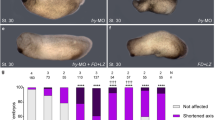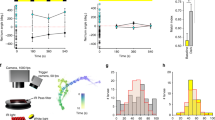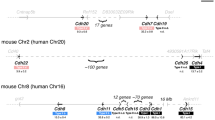Abstract
Embryonic morphogenesis is driven by a suite of cell behaviours, including coordinated shape changes, cellular rearrangements and individual cell migrations, whose molecular determinants are largely unknown. In the zebrafish, Dani rerio, trilobite mutant embryos have defects in gastrulation movements1,2,3,4 and posterior migration of hindbrain neurons5. Here, we have used positional cloning to demonstrate that trilobite mutations disrupt the transmembrane protein Strabismus (Stbm)/Van Gogh (Vang), previously associated with planar cell polarity (PCP) in Drosophila melanogaster6,7, and PCP and canonical Wnt/β-catenin signalling in vertebrates8,9. Our genetic and molecular analyses argue that during gastrulation, trilobite interacts with the PCP pathway without affecting canonical Wnt signalling. Furthermore, trilobite may regulate neuronal migration independently of PCP molecules. We show that trilobite mediates polarization of distinct movement behaviours. During gastrulation convergence and extension movements, trilobite regulates mediolateral cell polarity underlying effective intercalation and directed dorsal migration at increasing velocities. In the hindbrain, trilobite controls effective migration of branchiomotor neurons towards posterior rhombomeres. Mosaic analyses show trilobite functions cell-autonomously and non-autonomously in gastrulae and the hindbrain. We propose Trilobite/Stbm mediates cellular interactions that confer directionality on distinct movements during vertebrate embryogenesis.
This is a preview of subscription content, access via your institution
Access options
Subscribe to this journal
Receive 12 print issues and online access
$209.00 per year
only $17.42 per issue
Buy this article
- Purchase on Springer Link
- Instant access to full article PDF
Prices may be subject to local taxes which are calculated during checkout




Similar content being viewed by others
References
Solnica-Krezel, L. et al. Development 123, 67–80 (1996).
Sepich, D. S. et al. Genesis 27, 159–173 (2000).
Marlow, F. et al. Dev. Biol. 203, 382–399 (1998).
Hammerschmidt, M. et al. Development 123, 143–151 (1996).
Bingham, S., Higashijima, S., Okamoto, H. & Chandrasekhar, A. Dev. Biol. 242, 149–160 (2002).
Taylor, J., Abramova, N., Charlton, J. & Adler, P. N. Genetics 150, 199–210 (1998).
Wolff, T. & Rubin, G. M. Development 125, 1149–1159 (1998).
Darken, R. S. et al. EMBO J. 21, 976–985 (2002).
Park, M. & Moon, R. T. Nature Cell Biol. 4, 20–25 (2002).
Haffter, P. et al. Development 123, 1–36 (1996).
Driever, W. et al. Development 123, 37–46 (1996).
Sokol, S. Y. Curr. Biol. 6, 1456–1467 (1996).
Heisenberg, C. P. et al. Nature 405, 76–81 (2000).
Adler, P. N. & Lee, H. Curr. Opin. Cell Biol. 13, 635–640 (2001).
Nasevicius, A. & Ekker, S. C. Nature Genet. 26, 216–220 (2000).
Heisenberg, C. P. & Tada, M. Curr. Biol. 12, R126–R128 (2002).
Murdoch, J. N., Doudney, K., Paternotte, C., Copp, A. J. & Stanier, P. Hum. Mol. Genet. 10, 2593–2601 (2001).
Park, M. & Moon, R. T. Nature Cell Biol. 4, 20 (2002).
Lekven, A. C., Thorpe, C. J., Waxman, J. S. & Moon, R. T. Dev. Cell 1, 103–114 (2001).
Erter, C. E., Wilm, T. P., Basler, N., Wright, C. V. & Solnica-Krezel, L. Development 128, 3571–3583 (2001).
Wilson, S. W. & Rubenstein, J. L. Neuron 28, 641–651 (2000).
Heisenberg, C. P. & Nusslein-Volhard, C. Dev. Biol. 184, 85–94 (1997).
Marlow, F., Topczewski, J., Sepich, D. S. & Solnica-Krezel, L. Curr. Biol. 12, 876–884 (2002).
Myers, D. C., Sepich, D. S. & Solnica-Krezel, L. Dev. Biol. 243, 81–98 (2002).
Concha, M. L. & Adams, R. J. Development 125, 983–994 (1998).
Wallingford, J. B. et al. Nature 405, 81–85 (2000).
Topczewski, J. et al. Dev. Cell. 1, 251–264 (2001).
Trinkaus, J. P. J. Exp. Zool. 281, 328–335 (1998).
Chandrasekhar, A., Moens, C. B., Warren, J. T. Jr., Kimmel, C. B. & Kuwada, J. Y. Development 124, 2633–2644 (1997).
Higashijima, S., Hotta, Y. & Okamoto, H. J. Neurosci. 20, 206–218 (2000).
Moens, C. B. & Fritz, A. Methods Cell Biol. 59, 253–272 (1999).
Kibar, Z. et al. Nature Genet. 28, 251–255 (2001).
Peifer, M. & McEwen, D. G. Cell 109, 271–274 (2002).
Tree, D. R. P. et al. Cell 109, 371–381 (2002).
Kimmel, C. B., Ballard, W. W., Kimmel, S. R., Ullmann, B. & Schilling, T. F. Dev. Dyn. 203, 253–310 (1995).
Westerfield, M. The zebrafish book (University Oregon Press, Eugene, 1995).
Acknowledgements
We thank B. Appel, R. Blakely, A. Schier, and C.V.E. Wright for critical comments. We thank J. Clanton and C. Baccam for excellent fish care, M. Halpern for γ-ray-mutagenized fish, M. Westerfield, H. Takeda, P. Ingham, M. Ekker, Y. Grinblat, B. Thisse, C. Thisse, E. Weinberg and T. Jowett for probes, R. Harland, S. Sokol and M. Tada for constructs, and C.-P. Heisenberg and H. Okamoto for fish. S.B. and A.C. are indebted to K. Cooper and C. Moens for invaluable guidance in transplantation procedures. The Zeiss confocal microscope is supported by National Insitutes of Health (NIH) grant 1S10RR015682. J.R.J. and D.S.S. are supported by a National Institutes of Health Vascular Biology Training Grant (T32HL07751). S.B. is supported by a NSF-Missouri's Alliance for Graduate Education and the Professoriate (MAGEP) fellowship and A.C. by NIH grant NS40449. L.S.K. is supported by NIH grant GM55101 and Pew Scholars Program in the Biomedical Sciences.
Author information
Authors and Affiliations
Corresponding author
Ethics declarations
Competing interests
The authors declare no competing financial interests.
Supplementary information
Supplementary Methods and Figures
Figure S1. Positional cloning of tri. (PDF 283 kb)
Figure S2. Tri/Stbm does not regulate anteroposterior neural patterning.
Figure S3. Epistatic analysis of tri and PCP pathway components.
Rights and permissions
About this article
Cite this article
Jessen, J., Topczewski, J., Bingham, S. et al. Zebrafish trilobite identifies new roles for Strabismus in gastrulation and neuronal movements. Nat Cell Biol 4, 610–615 (2002). https://doi.org/10.1038/ncb828
Received:
Revised:
Accepted:
Published:
Issue Date:
DOI: https://doi.org/10.1038/ncb828
This article is cited by
-
A Yap-dependent mechanoregulatory program sustains cell migration for embryo axis assembly
Nature Communications (2023)
-
Live imaging and conditional disruption of native PCP activity using endogenously tagged zebrafish sfGFP-Vangl2
Nature Communications (2022)
-
Wnt/planar cell polarity signaling controls morphogenetic movements of gastrulation and neural tube closure
Cellular and Molecular Life Sciences (2022)
-
Dominant ARF3 variants disrupt Golgi integrity and cause a neurodevelopmental disorder recapitulated in zebrafish
Nature Communications (2022)
-
Exposure to ethanol leads to midfacial hypoplasia in a zebrafish model of FASD via indirect interactions with the Shh pathway
BMC Biology (2021)



